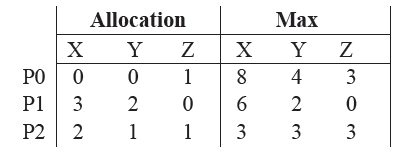50 Operating System MCQs with Answers
Question 21
Question 22
Question 23
Question 24
Three concurrent processes X, Y, and Z execute three different code segments that access and update certain shared variables. Process X executes the P operation (i.e., wait) on semaphores a, b and c; process Y executes the P operation on semaphores b, c and d; process Z executes the P operation on semaphores c, d, and a before entering the respective code segments. After completing the execution of its code segment, each process invokes the V operation (i.e., signal) on its three semaphores. All semaphores are binary semaphores initialized to one. Which one of the following represents a deadlockfree order of invoking the P operations by the processes? (GATE CS 2013)
Question 25
Which of the following is NOT true of deadlock prevention and deadlock avoidance schemes?
Question 26
Process P1:
t=0: requests 2 units of R2
t=1: requests 1 unit of R3
t=3: requests 2 units of R1
t=5: releases 1 unit of R2
and 1 unit of R1.
t=7: releases 1 unit of R3
t=8: requests 2 units of R4
t=10: Finishes
Process P2:
t=0: requests 2 units of R3
t=2: requests 1 unit of R4
t=4: requests 1 unit of R1
t=6: releases 1 unit of R3
t=8: Finishes
Process P3:
t=0: requests 1 unit of R4
t=2: requests 2 units of R1
t=5: releases 2 units of R1
t=7: requests 1 unit of R2
t=8: requests 1 unit of R3
t=9: Finishes
Which one of the following statements is TRUE if all three processes run concurrently starting at time t=0?
Question 27
if (i % 2 == 0) {
if (i < n) request Ri
if (i+2 < n) request Ri+2
}
else {
if (i < n) request Rn-i
if (i+2 < n) request Rn-i-2
}
In which one of the following situations is a deadlock possible?
Question 28
 There are 3 units of type X, 2 units of type Y and 2 units of type Z still available. The system is
currently in a safe state. Consider the following independent requests for additional resources in the
current state:
There are 3 units of type X, 2 units of type Y and 2 units of type Z still available. The system is
currently in a safe state. Consider the following independent requests for additional resources in the
current state:
REQ1: P0 requests 0 units of X,
0 units of Y and 2 units of Z
REQ2: P1 requests 2 units of X,
0 units of Y and 0 units of Z
Which one of the following is TRUE?
Question 29
Question 30
There are 50 questions to complete.
